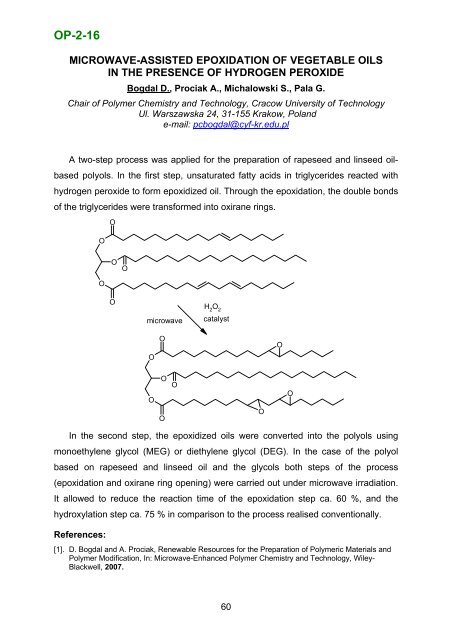- Page 1 and 2:
Boreskov Institute of Catalysis SB
- Page 3 and 4:
International Scientific CommitteeV
- Page 5 and 6:
PL-1DESIGN OF CATALYSTS AND CATALYT
- Page 7 and 8:
PL-3CATALYTIC TRANSFORMATIONS FOR P
- Page 9 and 10: PL-4In this contribution the princi
- Page 11 and 12: PL-5THEORETICAL AND EXPERIMENTAL AN
- Page 13 and 14: PL-6heat exchanging internals; dyna
- Page 15 and 16: CATALYTIC CRACKING OF SUNFLOWER SEE
- Page 17 and 18: KN-3CONVERSIONS OF WOOD AND CELLULO
- Page 19 and 20: CATALYTIC FUEL-GAS CLEANING IN A ST
- Page 21 and 22: BIO4ENERGY - THE SWEDISH QUESTFOR S
- Page 23 and 24: ORAL PRESENTATIONSSection 1.CATALYS
- Page 25 and 26: OP-1-2METHANOLYSIS OF VEGETABLE OIL
- Page 27 and 28: OP-1-4SYNTHESIS, CHARACTERIZATION A
- Page 29 and 30: OP-1-6THE PRODUCTION OF MOTOR FUEL
- Page 31 and 32: HYDROTREATMENT CATALYSTS DESIGN FOR
- Page 33 and 34: CATALYTIC HYDROTREATING OF FAST PYR
- Page 35: OP-1-11BIOMASS’ PRODUCTS TREATMEN
- Page 38 and 39: OP-1-14BIO-ETHANOL - PETROCHEMICAL
- Page 40 and 41: OP-1-15USING BIOMASS-BASED FUELS FO
- Page 42 and 43: OP-2-1COMBINATION OF METAL AND ACID
- Page 44 and 45: OP-2-3CELLULOSE HYDROTHERMAL CONVER
- Page 46 and 47: OP-2-4CATALYTIC CONVERSION OF CONCE
- Page 48 and 49: OP-2-6KINETICS OF SELECTIVE OXIDATI
- Page 50 and 51: OP-2-8PROCESS FOR THE PRODUCTION OF
- Page 52 and 53: OP-2-10BIODERIVED LACTIC ACID AND L
- Page 54 and 55: OP-2-11CATALYTIC CONVERSION OF HEMI
- Page 56 and 57: OP-2-13Cu CATALYSTS FOR HYDROGENOLY
- Page 58 and 59: OP-2-15Cu-CONTAINING CATALYSTS FOR
- Page 62 and 63: OP-2-18ULTRASOUND-INDUCED FORMATION
- Page 64 and 65: OP-2-20EFFECT OF Ag DOPING IN La-Mn
- Page 66 and 67: OP-2-22INSIGHTS IN GLYCEROL REFORMI
- Page 68 and 69: OP-3-1APPLICATION OF NOVEL CATALYST
- Page 70 and 71: OP-3-2REDUCING CONVERSIONS OF GLYCE
- Page 72 and 73: OP-3-4LOW-TEMPERATURE CONVERSION OF
- Page 74 and 75: OP-3-6H 2 PRODUCTION BY STEAM REFOR
- Page 76 and 77: OP-3-8CATALYTIC STEAM REFORMING OF
- Page 78 and 79: OP-3-10CATALYTIC GAS PHASE CONVERSI
- Page 80 and 81: ORAL PRESENTATIONSSection 4.BIOCATA
- Page 82 and 83: OP-4-2THE EFFECT OF OXYGEN MASS TRA
- Page 84 and 85: OP-4-4VALORIFICATION OF FERMENTATIO
- Page 86 and 87: OP-4-5MECHANISM OF ULTRASOUND-ASSIS
- Page 88 and 89: PP-1THE ORTHO - PARA CONVERSION OF
- Page 90 and 91: PP-3THREE-STAGE WASTE-FREE PROCESS
- Page 92 and 93: PP-4Н 2 О with formation superflu
- Page 94 and 95: PP-6HYDROGEN FROM FORMIC ACID DECOM
- Page 96 and 97: PP-8VALORIZATION OF GLYCEROL BY CON
- Page 98 and 99: PP-10BIODIESEL PRODUCTION FROM WAST
- Page 100 and 101: PP-11Figure 1. CHEMPAK architecture
- Page 102 and 103: PP-13HYDROCONVERSION OF VEGETABLE O
- Page 104 and 105: PP-15CaO AND Al 2 O 3 SUPPORT SOLID
- Page 106 and 107: PP-17CATALYTIC CRACKING OF GLUCOSE
- Page 108 and 109: PP-19[DBU][Ac]: A TASK-SPECIFIC ION
- Page 110 and 111:
PP-21SELECTIVE CONVERSION OF CARBON
- Page 112 and 113:
PP-23HYDROGEN PRODUCTION BY ETHANOL
- Page 114 and 115:
PP-25SUB- AND SUPERCRITICAL WATER A
- Page 116 and 117:
PP-27THE BLENDING OF SECOND - GENER
- Page 118 and 119:
PP-29STUDY ON THE PRETREATMENTS OF
- Page 120 and 121:
PP-31THERMAL CONVERSIONS OF WOOD SA
- Page 122 and 123:
PP-33PHYSICOCHEMICAL PROPERTIES OF
- Page 124 and 125:
PP-35LOW-TEMPERATURE OXIDATION OF O
- Page 126 and 127:
PP-37LABORATORY EQUIPMENT FOR THE S
- Page 128 and 129:
PP-39FERMENTATION PROCESSES OF FREE
- Page 130 and 131:
PP-41THERMOCATALYTIC HYDROLYSIS AND
- Page 132 and 133:
PP-43OBTAINING OF SYNTHETIC FUEL FR
- Page 134 and 135:
PP-44hydrogen. The highest values o
- Page 136 and 137:
PP-46PROBLEM OF RECEPTION OF ANTIMA
- Page 138 and 139:
PP-48INVESTIGATION OF NEW WAYS OF B
- Page 140 and 141:
PP-50DEVELOPMENT OF AN EFFICIENT ME
- Page 142 and 143:
PP-52ZEOLITE COATINGS ON SUGAR CANE
- Page 144 and 145:
PP-54PREPARATION OF ADVANCED ADSORB
- Page 146 and 147:
PP-56HYDROGENATION OF CIS-METHYL OL
- Page 148 and 149:
PP-57CAVITATION ASSISTED DESIGH OF
- Page 150 and 151:
PP-59KINETICS OF CATALYTIC GASIFICA
- Page 152 and 153:
PP-61ORGANOSOLV LIGNIN AS CHEMICALS
- Page 154 and 155:
PP-62which were taken in preset qua
- Page 156 and 157:
PP-64EXTRACTION OF HUMIC ACIDS FROM
- Page 158 and 159:
PP-66THE INVESTIGATION OF ASPECTS O
- Page 160 and 161:
LIST OF PARTICIPANTSNeisiani ABDOLL
- Page 162 and 163:
Andrey CHISTYAKOVA.V. Topchiev Inst
- Page 164 and 165:
Yusuf ISA MAKARFIM.V. Lomonosov Mos
- Page 166 and 167:
Nikolaj LAPINInstitute of Microelec
- Page 168 and 169:
Vitaly ORDOMSKYDepartment of Chemis
- Page 170 and 171:
Irina SIMAKOVABoreskov Institute of
- Page 172 and 173:
Elena VIALICHPerm State UniversityB
- Page 174 and 175:
ORAL PRESENTATIONS.................
- Page 176 and 177:
OP-2-18 Andreeva D., Schäferhans J
- Page 178 and 179:
PP-15 Dias A.P., Puna J.F., Gomes J
- Page 180 and 181:
PP-50Rustamov M.I., Abad-zade Kh.I.
- Page 182:
INTERNATIONAL CONFERENCECATALYSIS F
















